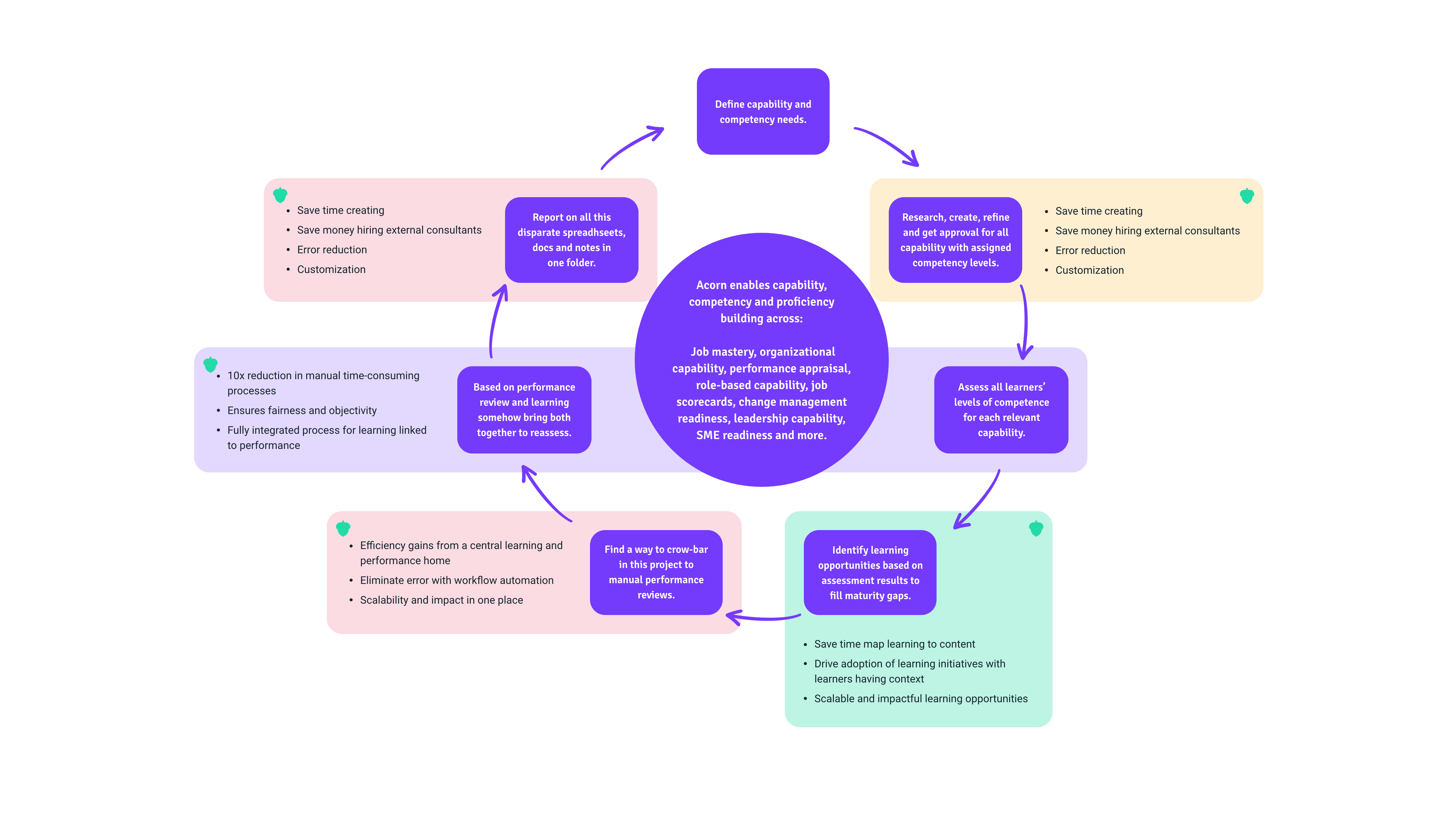A crucial step in the capability building journey is running organisational capability assessments. They create a birds-eye view of your organisation based on its strengths and weaknesses, mapping a blueprint for more strategic learning and development.
We’ll walk you through how to run effective and impactful organisational assessments in this article, with some tips on how to sell them to your workforce and the pitfalls to avoid.
How to run organisational capability assessments
Done right, the organisational capability assessment is a diagnostic tool used to evaluate the collective strength of an organisation’s skills, knowledge, behaviours, tools, and processes. It does this by evaluating individual capability, but the overarching goal is to understand the organisation’s capacity to achieve its strategic goals.
Before you start, you should be looking at capability assessments as close to BAU as possible. Capability assessments underpin continuous improvement in your workforce, which is why the process for running them looks something like this:
- Identify capabilities that are core to business
- Assess organisational capability maturity
- Design strategies to build and enhance capability
- Reassess and restart the cycle.
1. Identify core organisational capabilities
Compared to whole of workforce or individual capability assessments, which look at operational flaws, the organisational version asks you to think strategic and consider capability maturity.
A strategic frame derives from your CEO’s needs and wants. That means defining what capabilities are crucial to your organisational goals and the resources needed to sustain and drive them forward.
It helps to organise capabilities by their role in business. We usually recommend six categories total.
- Operational: The ability of an organisation to efficiently and effectively carry out core activities.
- Strategic via critical success factors (CSF): Specific activities that drive competitive edge, set by business leaders.
- Strategic via firm resources: The use of resources (financial, human, physical) to drive competitive edge.
- Dynamic: The organisational ability to stay agile and adapt to change.
- Behavioural: The human ability to know what to do and how to do it.
- Structural: Organisational structures (obviously) and systems that underpin success.
When capabilities are derived and defined by strategy, it’s easier to create internal alignment around priorities (but more on that later).
2. Assess capability maturity across your organisation
With the lay of the land outlined, we turn to finding pockets of strength and weakness across the business. Think of this as a holistic health check for your organisation.
We recommend using a collection of assessments to understand how capabilities are performed. Within our Acorn Performance Learning Management System (PLMS), we have three options: Self-assessment, manager assessment, and subject matter expert assessment. Each is done based on competency levels, i.e., a scaled measure of performance that follow a pattern like:
- Foundational
- Intermediate
- Adept/proficient
- Advanced
- Highly advanced/strategic.
Each level would come with a description of performance to guide objective evaluation. Completed in the same system employees train in, these assessments allow leaders to visualise capabilities in terms of the level of competency they are currently performed at.
But back to maturity. It can also be measured on a similar scale to competency, but as it’s the strategic view, it looks like:
- Initial, where work is unpredictable and reactive.
- Managed, where work is managed project to project.
- Defined, where work is planned proactively, rather than reactively.
- Quantitatively managed, where work is data-driven, measured, and controlled.
- Optimised, where work is stable, agile, and consistently innovated on.
Which, in turn, can be cross-referenced with other functions to create an organisational capability map. This will differ from other capability artefacts, like your framework, in that it should be regularly changed based on the information derived from regular assessments. (If you’re working towards a specific business goal, a middling level of maturity isn’t ever going to propel you forward, you know?)
The main aim of maturity assessments is prioritisation. Done within Acorn PLMS, you are given data-driven insights that show:
- What areas are a) closest to the money and b) performed below ideal standard or not at all, and therefore in need of immediate attention.
- Areas of strength, potentially helping to identify core capabilities.
3. Develop strategies to enhance organisational capabilities
Capability building is powered by a truly strategic L&D function, and we created Acorn PLMS to power L&D, HR, OD, and talent to have impact.
McKinsey notes there are typically four sequential steps for capability building.
- Individuals learn new capabilities
- Teams apply them, and capability changes at scale
- Operational effectiveness improves
- The organisation profits and hits goals.
So, to go back to that opener on having strategic impact, the initiative here is to embed performance management within learning and development.
But we have to start on the right foot before learning begins. (By the way, a major part of this is running organisational capability assessments.) Do you know what your organisation’s goals and strategic direction are? You shouldn’t rely solely on strategic capabilities to paint this picture—revisiting mission statements, product and service offerings, and even talking with leadership will cement the ultimate objective.
Take the opportunity to understand pain points in conversations with leadership. Capability building should be purpose-built, which means knowing the KPIs leaders need to hit and the hurdles stopping that. Look to supplementary tools, like job scorecards, to understand what performance outcomes will have the timeliest impact for employees, function, and business.
You also want to make assessment of learning and performance routine. Acorn’s Momentum feature was designed to automate processes like this, so the system will automatically notify employees of upcoming assessments at a frequency of your choosing. (And then it’ll tell managers when team members have completed assessments, too.)

When it comes to learning itself, you need to think beyond what legacy learning management systems are doing (which is overwhelming amounts of content sitting in a library). Powered by AI, Acorn PLMS can push the right and relevant content in front of learners, at the right time, by mapping content to individual capabilities. This ensures you’re serving up truly contextual learning experiences, and guiding learners to develop the key capabilities that’ll help them master their job roles and accelerate organisational performance.
And to go that extra mile, Acorn enables you to capture learning that is already happening within the workplace and otherwise lost. By recording or noting key interactions (e.g., a sales call that sold your narrative perfectly, or the most efficient method for development on a tech feature), you can create contextual learning assets that encourage learning in the flow of work and promote knowledge transfer at scale.
To close the loop, learner history and progression, team reporting, and performance management are housed in a central location. That’s efficiency gains for reduced manual data validation, and a scalable, streamlined process for aligning capabilities with business goals.
4. Reassess capabilities
To truly see this process through to its full potential, you need to take stock of what’s worked and what’s not. The outcome of capability assessments should be change at the least and transformation at best.
Ergo, re-assessing organisational capabilities will give you two forms of insight. First, you’ll understand if you’re impacting business outcomes. Second, you should uncover weaknesses in your methods to close capability gaps. Combined, this insight is the turnkey when codifying process improvement (and making smart L&D investments).
To make this BAU for capability building, it’s best to embed capability assessments in key milestones.
- As mentioned, make capability assessments the first part of learning needs analyses before training design.
- Pace performance conversations throughout training to evaluate if learning outcomes are being met—remember that Momentum can automate reminders for these, too.
- Utilise heat maps to show the availability of a capability against its strategic importance.
The importance of organisational capability assessments
Let’s start with a clear explanation of capability. Organisational capability refers to the skills, knowledge, behaviours, tools, and processes that combine to deliver on organisational objectives. An organisational capability assessment is, therefore, a tool with which to assess the strength, weakness and availability of said capabilities.
That’s not to be understated in the business landscape. Harvard Business Review research found that while 82% of organisations think they’re strategically aligned, only 23% actually are. The same study found that functional silos created different understandings of organisational strategy, with echo chambers forming in teams that only further the divide on priorities.
Disengagement or disillusionment with (or even simple misunderstanding of) business strategy is lethal. Capability building at its core is about changing and optimising how work gets done; assessments are the momentum powering continuous improvement. If you don’t have an accurate read of capability maturity at any given time, you have to assume you’re behind competitors and innovation.
That’s generally because your workforce is, well, working inefficiently or ineffectively. And how would you really know, without capability assessments, where the actual issue is? Symptoms can mask themselves as problems; is the issue that people don’t know what the business’s strategy is, or that they haven’t been given the tools and resources to understand it?
Where capabilities are truth north, capability assessments act as the compass for alignment. They codify ideal performance based on business needs, giving:
- Employees license to engage in training; and
- L&D, HR, organisational development, and talent professionals information with which to better deploy resources.
That powers your organisation’s execution engine, with which it can continuously and sustainably create value.
Why and how organisations get capability assessments wrong
As with most business initiatives, lack of buy-in is the real killer for organisational capability assessments, which is generally a sign that you didn’t prove their value of them.
As we said earlier, if you don’t know what your organisation is trying to do, assessments become vague and ineffective. It’s like trying to solve a puzzle with missing pieces, or without the image of the finished puzzle to guide you; any assessments done won’t provide actionable insights, since you won’t know what’s the highest priority. It also signals to leaders and employees alike that assessments are a waste of time, considering negligible returns on their investment.
Taking a manual approach to assessments also stop-gaps the process. What you end up with is multiple spreadsheets of capability data across many hard drives. And even if you can centralise them, you’ve likely got a beast of a master spreadsheet that doesn’t make it easy to visualise data for stakeholders and decision-making. The more time is spent on manual data validation, the further the gap gets between your organisation’s current and desired state.
It’s not totally your fault in that regard. Introducing new software generally requires the approval of people who don’t even use it, or favour a legacy product over change, and most of the workflow systems out there still add another house to the community that is your HR, L&D, and payroll tech stack. This is another reason we built our workflow engine, Momentum, as a feature of our PLMS and not its own product; L&D can’t truly impact performance if the mechanisms for performance and learning are separate. Why add another step to the journey that costs time and money?
And above almost all except for strategic alignment, capability assessments don’t work when they are only used annually. Would you only review the budget yearly? How about recruitment? Performance targets and KPIs too? When you relegate performance management to a one-off endeavour, you’re essentially making decisions in those other processes blind.
Key takeaways
Don’t look at organisational capability assessments—or any capability assessments—as tasks that tick a compliance box. They should be a key part of your capability building process.
Done right, capability assessments can:
- Diagnose the root problems of performance
- Identify high performers and areas of strategic strength
- Highlight areas of weakness for timely L&D interventions
- Better inform resource allocation.
Continuous capability assessments that bookend performance and learning management practices ensure you’re always making incremental improvements in the right direction. And that positions L&D as a strategic business partner with their finger on the pulse of business needs. We call that a win-win.
Related Reads on This Topic

How to Get Job Scorecards Right with Competency Frameworks
Discover the secret to writing job scorecards that align employee performance with business outcomes using a competency framework…

How to Conduct a Capability Gap Analysis for Organisational Development
We dive into what a capability gap analysis is, how to do one, and how it can help drive organisational development in your business…

What is a Capability Academy & Why Should You Be Using One?
Capability academies are crucial for building capabilities in your business. We discuss best practices for building them…